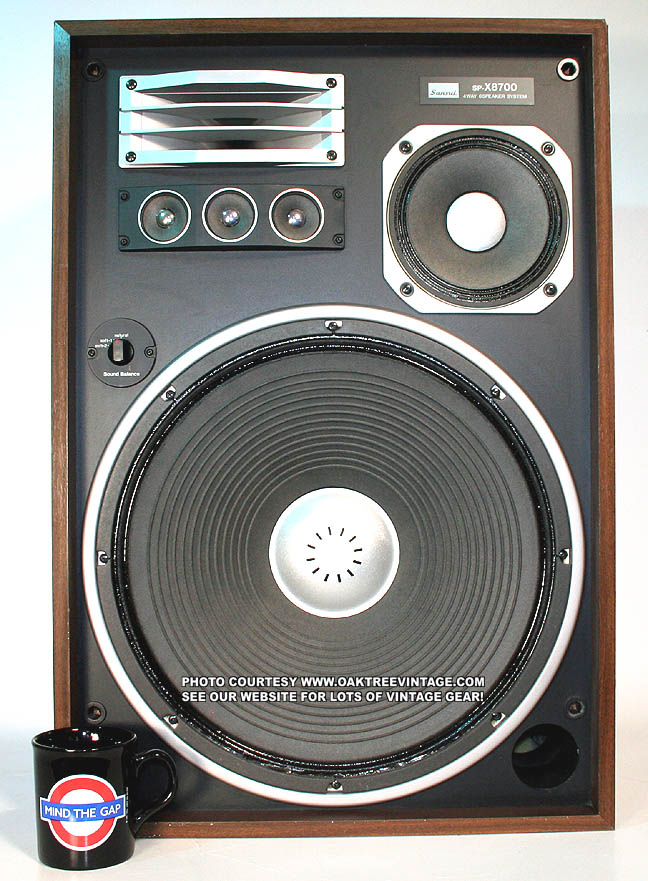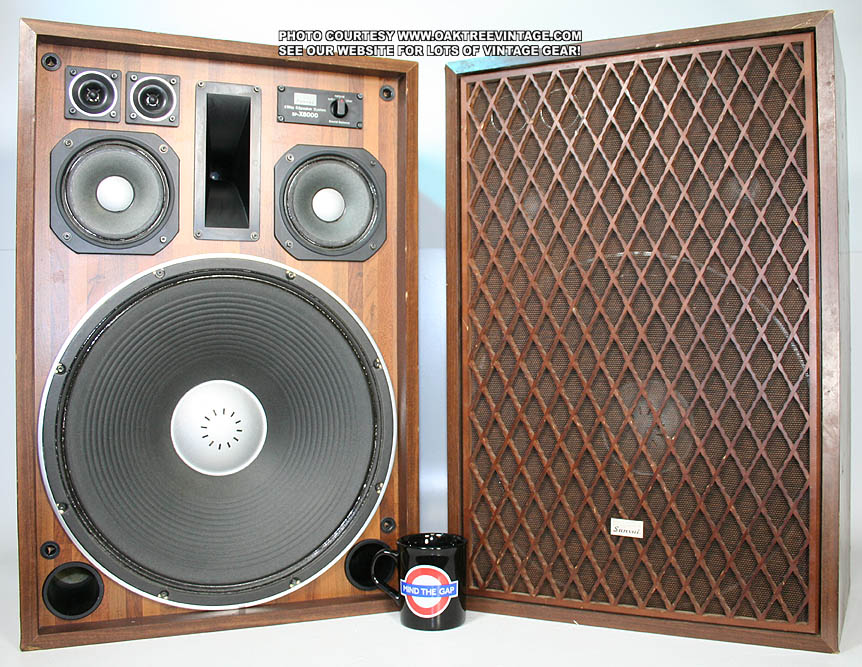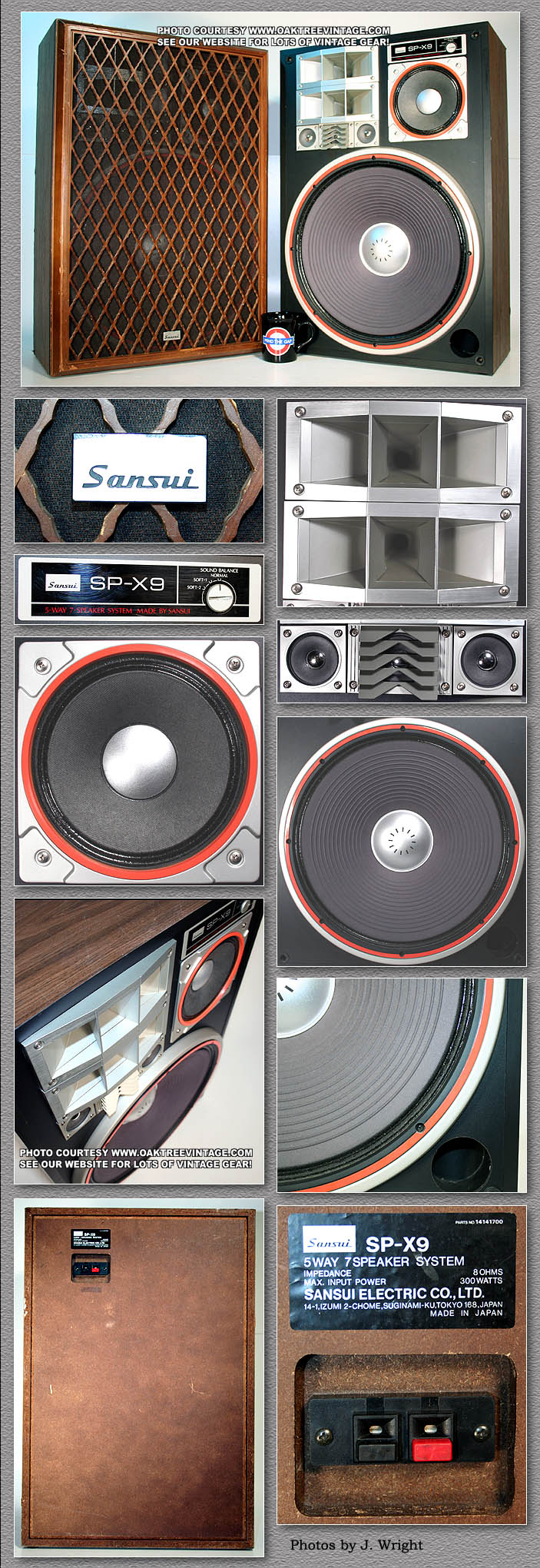Playing with and without Passive radiator...

Mystery
Posts: 2,546
I've been playing RTA-11t this morning without one PR and they sound good.
There is good bass as well on both sides. I think they both sound pretty much same.
Since PR is kinda acting as a port, not having it there at all is like having a huge 8" round port.
I'm sure the port that PR replaced will be much smaller.
Has anyone played vintage monitors/RTA/SDA's without PR just to see how they sound?
I wonder if the sound is too different to notice by ears or need some meters.
Ported vintage polks.
There is good bass as well on both sides. I think they both sound pretty much same.
Since PR is kinda acting as a port, not having it there at all is like having a huge 8" round port.
I'm sure the port that PR replaced will be much smaller.
Has anyone played vintage monitors/RTA/SDA's without PR just to see how they sound?
I wonder if the sound is too different to notice by ears or need some meters.
Ported vintage polks.
Klipsch RB81, KG3.5, B&W DM602.5, Polk.
Subwoofers: Klipsch RW10, Triad ProSub Bronze.
Post edited by Mystery on
Comments
-
The PR works by providing equivalent mass to the air in true port (vent) of a Helmholttz resonator. The tuning of a large box with a large (but very shallow - the thickness of the baffle panel) in it will be quite different than the equivalent vented box. How audible it'll be? Sounds like you've experienced that empirically ;-)
FYI, the important parameters of a port are its volume (not its diameter per se) and the mass of the air therein.
http://www.loudspeakerdesign.co.uk/bass_reflex.php
Tell us the inside dimensions of the box and we can calulate the resonant frequency of the Helmholtz resonator you've created :-) -
This^^^^^^^
You also risk damaging the drivers, since they are essentially un-damped. They could very easily exceed their excursion limits, damaging the voice coil, spider, and possibly tearing the thin rubber surrounds Polk used.Home Theater/2 Channel:
Front: SDA-2ATL forum.polkaudio.com/discussion/143984/my-2as-finally-finished-almost/p1
Center: Custom Built forum.polkaudio.com/discussion/150760/my-center-channel-project/p1
Surrounds & Rears: Custom Built forum.polkaudio.com/discussion/151647/my-surround-project/p1
Sonicaps, Mills, RDO-194s-198s, Dynamat, Hurricane Nuts, Blackhole5
Pioneer Elite VSX-72TXV, Carver PM-600, SVS PB2-Plus Subwoofer
dhsspeakerservice.com/ -
Mystery wrote:Has anyone played vintage monitors/RTA/SDA's without PR just to see how they sound?
That is an extremely bad idea.westmassguy wrote:You also risk damaging the drivers, since they are essentially un-damped. They could very easily exceed their excursion limits, damaging the voice coil, spider, and possibly tearing the thin rubber surrounds Polk used.
^^THIS^^Political Correctness'.........defined
"A doctrine fostered by a delusional, illogical minority and rabidly promoted by an unscrupulous mainstream media, which holds forth the proposition that it is entirely possible to pick up a t-u-r-d by the clean end."
President of Club Polk -
Make no mistake - a hole is a tuned port. A big box with one hole in it will have a resonant frequency; this is not magic, it's science, dang it! - it's not necessarily right for the driver in question, though. That doesn't mean it's not tuned.... heck, blow across an earthenware jug or an empty 2L soda bottle and hear the tuning of each.
The issue of driver loading is not a trivial consideration... but it's also not necessarily a death sentence for the woofer. It depends on the driver's physical and electrical properties, program material and amplification (power). Feeding a few hundred milliwatts even full range not likely (likely) to do any harm even at or below Fs. No guarantee express or implied, though. -
A few watts may not harm it, but will likely sound like a clock radio with zero bass.
-
mhardy6647 wrote: »Make no mistake - a hole is a tuned port. A big box with one hole in it will have a resonant frequency; this is not magic, it's science, dang it! - it's not necessarily right for the driver in question, though. That doesn't mean it's not tuned.... heck, blow across an earthenware jug or an empty 2L soda bottle and hear the tuning of each.
The issue of driver loading is not a trivial consideration... but it's also not necessarily a death sentence for the woofer. It depends on the driver's physical and electrical properties, program material and amplification (power). Feeding a few hundred milliwatts even full range not likely (likely) to do any harm even at or below Fs. No guarantee express or implied, though.
That's misleading at best. I tuned port means someone took the time to do the proper calculations. This situation is a hole resulting from a PR that was removed, there's was no tuning involved. Sure it will react at some unknown frequency, but I would never operate a Polk with the PR removed at any volume. The drivers are 20+ years old, and for some, there's no exact replacement. Why take the risk? It would be safer to operate it with the hole temporarily sealed, than nothing at all.Home Theater/2 Channel:
Front: SDA-2ATL forum.polkaudio.com/discussion/143984/my-2as-finally-finished-almost/p1
Center: Custom Built forum.polkaudio.com/discussion/150760/my-center-channel-project/p1
Surrounds & Rears: Custom Built forum.polkaudio.com/discussion/151647/my-surround-project/p1
Sonicaps, Mills, RDO-194s-198s, Dynamat, Hurricane Nuts, Blackhole5
Pioneer Elite VSX-72TXV, Carver PM-600, SVS PB2-Plus Subwoofer
dhsspeakerservice.com/ -
True... I didn't imply it was tuned to a useful resonance for the driver at all (re-read my post(s) if you doubt that); but the idea that it is non-resonant is contrary to the physics. I know what you're getting at, but I am sensitive to accuracy in terms of physics, too. I get prissy (note the "r"!) about stuff like this because the less consumers and hobbyists understand (or at least are aware of) fundamental concepts, the easier it is for companies to hoodwink 'em... and there is plenty of hoodwinking in this hobby (more than ever, by my assessment).Sure it will react at some unknown frequency
Well, that's extremely conservative. ...and there is nothing wrong with that. You're right, for a tyro, probably better not to experiment - but I didn't think of Mystery as a tyro nor unaware of the risks of driving an unloaded driver at or below Fs.... but I would never operate a Polk with the PR removed at any volume.
Of course, all the folks who crow about having 200 watts or 400 watts or whatever per channel... yeah, they might want to be a little cautious.
I am pretty used to experimenting with components considerably costlier and rarer than the drivers in question, so I am not exactly prone to recklessness... your point, which I take to be not to encourage others to be reckless, is, however, well taken. -
I meant no disrespect, or intended to question your knowledge. I just had visions of some n00b running across this thread, and figuring, hey I can pull the PRs and get great bass, or concluding that because some subwoofers used In a car, using the trunk as a pseudo infinite baffle would apply to Polks. I have customers that send me woofers to re-foam, that had been operated for months with deteriorated surrounds. When I tell them they need a re-cone, not a re-foam, because the voice coils are peened over at the bottom from hitting the back plate, they think I'm trying to BS them and sell them something they don't need.Home Theater/2 Channel:
Front: SDA-2ATL forum.polkaudio.com/discussion/143984/my-2as-finally-finished-almost/p1
Center: Custom Built forum.polkaudio.com/discussion/150760/my-center-channel-project/p1
Surrounds & Rears: Custom Built forum.polkaudio.com/discussion/151647/my-surround-project/p1
Sonicaps, Mills, RDO-194s-198s, Dynamat, Hurricane Nuts, Blackhole5
Pioneer Elite VSX-72TXV, Carver PM-600, SVS PB2-Plus Subwoofer
dhsspeakerservice.com/ -
Yup, and you are exactly right about the down side of that!I just had visions of some n00b running across this thread, and figuring, hey I can pull the PRs and get great bass -
Okay... theories are good but as mentioned, it's not a killer.
I played them yesterday for around 3-4 hours (until I got replacement PR from Larry) at louder than normal volume and at times pretty loud to compare woofer movement in the two cabinets to check if lack of PR makes any difference.
The one without PR has slightly less vibrations/movement on the drivers/high PR and bass notes end little quicker than the one with PR but the sound difference is not that huge to say, "Oh the one without PR is crap". Nope, not at all.
I played same portion of the track back and forth switching left and right speakers and sound is almost the same except the one I mentioned above on bass notes.
So, to conclude, it's not a good idea but if you are waiting on a replacement PR, it's no harm to play them at normal levels if you have to play them.
Klipsch RB81, KG3.5, B&W DM602.5, Polk.
Subwoofers: Klipsch RW10, Triad ProSub Bronze. -
well... "at normal levels" is definitely tending towards Risky Business (again, given the kind of firepower that tends to be common around these parts).
-
Just an example of a properly tuned PR vs a large hole in the front baffle.
 "He who fights with monsters should look to it that he himself does not become a monster. And when you gaze long into an abyss the abyss also gazes into you." Friedrich Nietzsche
"He who fights with monsters should look to it that he himself does not become a monster. And when you gaze long into an abyss the abyss also gazes into you." Friedrich Nietzsche -
Perfect! That is exactly what's needed for this thread - I thought about doing the calculations 'by hand' but I am too danged lazy.
That "hump" (sub-critical damping) is what Mystery's hearing... the stress on the (unloaded) driver below 50 Hz or so is where most of the risk is coming from. Note that the LF rolloff is identical for both tunings (they're both bass reflex alignments) - the difference is in damping at/around resonance.
Do those plots represent something close to the T/S parameters of the Polk woofers in question?
The (system) impedance curves would also be interesting to compare.
As a side note, starting in the late 1960s and even into the 1980s, it was not uncommon for speaker designers to deliberately tune systems to fairly high Qtc to give just that kind of mid-bass hump... because it's impressive to an untrained ear on first hearing... ahem, cough-cough... Radio Shack... ahem. ;-) The "Kabuki" speakers made by most (if not all) of the major Japanese brands back in those days are classic examples. In those cases, the design approach was a very large woofer in a very small sealed box; the net effect is quite similar.
some "Kabuki" Sansuis from good ol' Oaktree...


...and one of the most puzzling (to me) 1970s loudspeaker faves of all...
dunno if that last one'll hot link... -
Great debate here. i will put my sopin on what apparently has already been covered just in case a noob would stumble across this and could possibly use a little more clarification.
Any hole in a speaker cabinet is a tuned port. This is speaking only in technical terms and is pretty much absolute. This does not mean that it was tuned to any certain desired frequency by the original designer. however it may have been. My Monitor 5 jr's are a good example. The actual tuning frequency of said tuned port depends on several other factors. primarily being enclosure volume, port length along with port area. I intentionally word this slightly different from Mhardy because not all holes or ports are round. Also you can achieve the same tuning with different volume ports. In a basic sense a smaller area port could be shorter where as a larger area port would need to be longer for the same tuning frequency. granted smaller ports tend to generate more port noise and are less desireable (one big benefit of PR's). With the large very short port (hole) described by Mystery the tuning of said hole/port would tend to be fairly high in frequency, but would have a particular resonant frequency none the less. The danger with this is playing high volumes as already mentioned. This is due to the fact that vented enclosures tend to unload the drivers below the tuning frequency of the port/ hole. with this unloading overexcursion can be a real danger as the enclosure is not controlling the driver, only the drivers suspension.
Another aspect of tuning is related to another discussion in another thread currently; enclosure losses and panel resonance/ vibration. A perfectly tuned enclusre should have as little panel flex as possible. This keeps the internal volume of the enclosure constant. Imagine a tire as you ride down the road and hit a pot hole additional pressure is applied to the tire causing the air inside to compress with greater force which in turn causes the side walls to expand and flex. this is what happens in a speaker cabinet when the drivers are moving (albeit to a lesser degree). At the tuning frequency of a port/ hole the pressures inside the cabinet are greatest. This frequency plays a significant role in cabinet flex and resonance. Sympathetic vibrations and resonsance are for the most part a different matter altogether.
My opinion would be that most vintage polks accept these things more easily than other designs. The start with fairly large enclosuers to begin with, the drivers are loose and are designed for pretty high excursions already for a speaker their size. These two things are probably the reasons why Mystery heard no more problems with the speakers. Though my thoughts would be that they may have sounded worse than he makes it sound or has much less critical hearing than myself. Either way this type listening would not be encouraged for any more than driver testing.
I stumbled into an issue with this many years ago while competing in automotive spl competitions. Our cabin (car) volume was 47+ cubic feet with a simialr enclosure volume. Port was over 6 square feet in area tuned to roughly 70 hz. in testing one day with the port removed I naturally found the resonance shifted upwards but also found a sginificant gain (well probably would be considered minor to most but in competition every little bit counts especially when approaching 170+ db. After this "revelation" and adjustment to frquency we used we then ended up with the same cabin volume but then utilyzed the enclosre volume instead of port to tune the system. this ended up in a very significant gain in spl and an enclosure volume of over 90 cubic feet. This was all in a short period. other adjustments and tuning were made before we retired the car but this was a very significant discovery at the time for us. keep in mind the port was now just a hole which was 6+ cubic feet and 1 inch long. howeve it was very much a tuned port, however it was not tuned by adjusting it's length or area in any way.If con is the opposite of pro, is Congress the opposite of Progress?!
Monitor 5Jr, Monitor 5, RTA12, RTA 15TL, SDA 2A, 1c, SRS 2, 1.2TL, CRS, Atrium. -
Actually the important variable is in fact the volume of the port; more precisely the mass of air in the port. The geometry is (in theory, if not necessarily in practice) irrelevant. Things like rectangular prisms (boxes) or cylinders are easy to calculate :-)
http://www.phys.unsw.edu.au/jw/Helmholtz.html -
I agree that it is a relation to volume of the port but a certain frequency of tuning can be achieved with many different volume ports, depending on the port diameter.
using the basic port length formula LV= [(1.463 x 10^7 x R^2) / (Fb^2 x Vb)] - 1.463xR and assuming a 4 cubic foot enclosure and a tuning of 35 hz and for simplicity assuming a round port, solving for a length using a 6 inch diameter port would yield a port 11.162 inches in length for a port volume of 315.587 cubic inches. While using the same fixed variables as before but assuming a 12 inch diameter port (I realize this is extreme but makes an easy to understand example) the length would be 53.42 inches and the associated port volume would then be 6042.155 cubic inches. An extreme difference in volume of the port for the same enclosure with the same tuning.
Also keep in mind that because tuning is due to mass of air inside the port, the tuning frequency also changes with air density, temperature, humidity, etc.If con is the opposite of pro, is Congress the opposite of Progress?!
Monitor 5Jr, Monitor 5, RTA12, RTA 15TL, SDA 2A, 1c, SRS 2, 1.2TL, CRS, Atrium. -
Gotcha!



